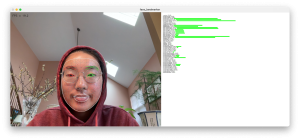This week, as a team, we incorporated all the feedback from the proposal presentation and started coming up with a more concrete/ detailed plan of how we will implement each feature/ data collection for the camera and EEG headset.
Lastly, we met with Dr. Jocelyn Dueck on the possibility of collaborating on our project. We will be using her expertise in her understanding of the flow/focus state of her students. She will help us collect training data for EEG-based focus level detection as she is very experienced in telling when her students are in a focused vs unfocused state while practicing. She proposed the idea of anti-myopia pinhole glasses to artificially induce higher focus levels, which can be used for collecting training data and evaluating performance.
Overall, we made great progress this week and are on schedule. The main existing design of our project stayed the same, with only minor adjustments made to the content of our proposal/ design following the feedback from our presentation last week. We look forward to continuing our progress into next week.





